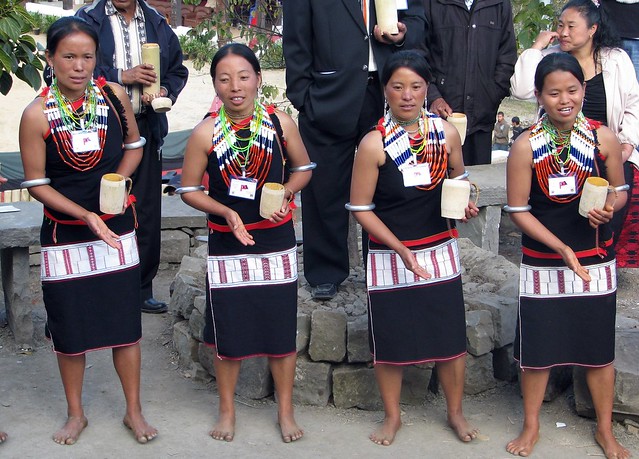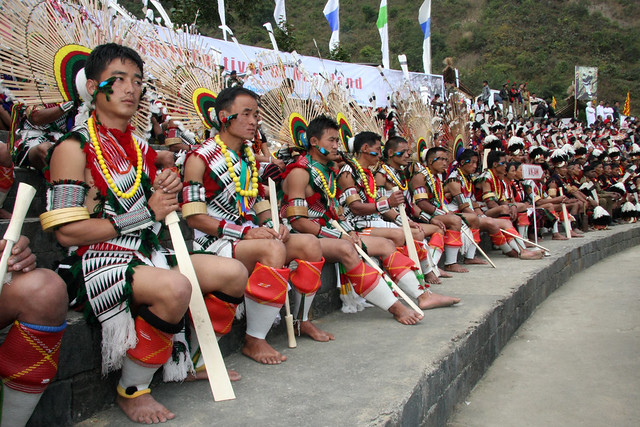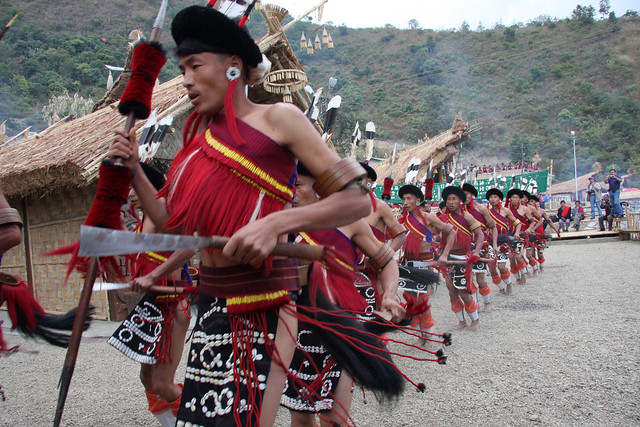Wildlife of Nagaland
The state has two wildlife sanctuaries. Fakim Wildlife Sanctuary and Intanki Wildlife Sanctuary.
Fakim Wildlife Sanctuary
The Fakim Sanctuary in Nagaland is nearby the border of Myanmar. It is full of numerous flora and fauna. You will find the trees of Bonsum, Bogipoma, Khasi Pine, Oaks, Amari, Gamari, Hollock, Nahor, Uriam, Alder, Kachnar, Sasi here. As the foprests here receive plenty of rains, the woods are brimmed with undergrowth shrubs, Dalchini and Tejpatta. If you will go in the months of March and April, you will gte to see blooming Rhododendrons, varieties of Bamboo and Cane.
The fauna of the sanctuary is packed with Tiger, Hoolock gibbons, Panther, Jungle Cat, Himalayan Bear, Bison, Sambar, Barking Deer, Wild Boar, Slender Loris. Some beautiful birds that are found in this sanctuary are Indian Horn Bill, Tragopan Pheasant, Grey Pheasant, Jungle Fowl, Green Pigeon, Doves etc are the important birds of the region.
Intanki Wildlife Sanctuary
The Intanki Wildlife Sanctuary in Nagaland is preserves by the Forest Wildlife Department. It is a shelter to various animals including some rare species of birds. The sanctuary boasts of having rich and varied treasure of flora & fauna. This Sanctuary is a home to Hoolock Gibbon (the only Gibbon found in India), Elephant, Mithun, Sambar, Barking Deer, Goral, Flying Squirrel, Wild Dog, Tiger, Sloth Bear. The birds you can locate here are Kaleej and common pheasant, Hornbill and Black Stor.
Cities of Nagaland
 |
| Kohima War Cemetery |
Kohima: The capital city of Nagaland is a home to Angami, Rengma, Kuki and Zeliang Naga tribes. The city is remarkable for the history of World War II. For tourists it has religious, monumental, museums and village attractions. Must visit places are The Cathedral of Reconciliation (a modern church), War Cemetery, State Museum, Zoological Park and two beautiful villages of Bara Basti and Khonoma.
The Dzukou Valley in Kohima is extremely beautiful. The hills, the cliffs, the landscape, the brooks, are ultimately vibrant. The valley is all the more beautiful and fragrant in the season of spring with blossoms all around. The herbs, the flowers like white, red, yellow and pink rhododendrons, yellow Caltha Palustris and white anemones. Different flowers dominate different seasons. Surprisingly 360 varieties of orchids grow in the hillsides.
 |
| Kiphire Tourism |
Kiphire:This tourist hot spot has many attractions like Saramati Peak (the highest peak of Nagaland), Fakim Wildlife Sanctuary, Cave at Salomi, Cave at Mimi, Sukhayap (Lover's Paradise),
Wawade Waterfalls, Twin Stones, Village of Siphi, Mikhi (the river of salt) and Yingphi or Yingphire (absolutely rich in historical spots, legends and traditions).
Longleng: Mokokchung: If you visit Mokokchung, do check out these spots of interest Longkhum, caves of Fusen kei and Mongzu Ki, Longritzu Lenden and Tangkum Marok (springs), Ungma ( oldest and the largest Ao village) and Chuchuyimlang (festival village of Ao).
Peren: This tourist village is abound with ethnicity and traditions. The famous tourist attractions of the distrisct are Benuru (rich in traditional values), Mt. Pauna Tourist Village and Mt. Pauna (the third highest peak of Nagaland).
 |
| Dimapur Tourism |
Dimapur: This “City of River People”, is the biggest and most advanced industrialized city of the state. The District derives its name from a dialect of Kachari in which ‘di’ - means river, ‘ma’ - means great or big, and ‘pur’ - means city, together denotative as ‘the city near the great river’. You can enjoy sightseeing in Dimapur at Chumukedima (the first headquarters of the erstwhile Naga Hills District of Assam State when there was reign of British in early 19th century), Ruzaphema (for frolic and shopping of handicrafts), Triple
Falls (a three tier waterfall), Governor's Camp (picnickers, rafters, anglers and campers delight) and Itankagi Wildlife Sanctuary.
Festivals of Nagaland
Nagaland is a place where fairs and festivals are celebrated round the year. Various tribes and village observe diffent festivals. Among the famous ones are:
Festivals of Angami: This tribe celebrates SEKRENYI in the month of February to seek health and welfare of the whole community. People are all glad and happily celebrate by boozing, and eating pork.
Festival of Ao: The Ao tribe observe MOASTSU MONG for three days in the month of May after completing sowing. The festival is occasion of celebration, dancing, singing and frolicking. 'Sangpangtu' is one of the symbolic celebrations of this festivals where men and women sit around a big lit fire. Another festival of Aos is TSUNGREM MONG in the August. This festival is for upcoming generation and village youths to exhibit their intellectual dexterity and physical prowess.
Festival of Chakhesang: This community celebrates seven festivals in whole year which are SUHKRUHNYE - 15th January, NGUNYE - 1st February, TSAKRONYE - 1st Sunday of March 4, TSUKHANYE / TSUKHENYIE - 6th May, KHUTHONYE - 15th July, TURHINYE - 25th August, THURINYE / KHILUVATU - 1st December. SUHKRUHNYE is the most important festival of this tribe.
 |
| Chakhesang Festival |
Festival of Zemi: SANKARNI is the most important festival of Zemis. It is celebrated at the same time when Sivaratri is celebrated. A week long festival is for smoking and boozing for merriment.
Festival of Sumi: The sumis celebrate a post harvest festival AHUNA which bespeaks the manifestation of thanks giving spree. TULUNI another festival which is celebrated in mid July. People drink wine named Tulini a rice beer.
 |
| The Hornbill Festival |
The Hornbill Festival: It is not a traditional festival of Nagas but a showcase of of Naga culture, cuisine and handicrafts. Different tribes display their own unique cultural assets. Musical gigs and various entertainment programs keep the tourists and the participant occupied with conviviality.












